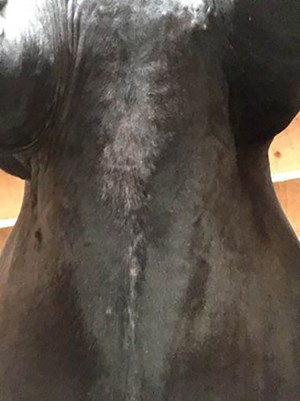
Sweet Itch in Horses
By: Dr. Lydia Gray
Updated 5/15/2017
Causes
“Sweet Itch,” also known as “summer itch” or summer seasonal recurrent dermatitis (SSRD), is an allergic reaction to the Culicoides biting midge or “no-see-um” gnat, although horses can develop allergies to other insects such as black flies, horn flies, and stable flies. Insect hypersensitivity like “sweet itch” is the most common allergy in horses, and it is also the most common cause of itching. Certain breeds like Welsh ponies, Icelandic horses, and Shires are predisposed to the condition meaning it is likely inherited, although any horse can develop “sweet itch” when exposed to the saliva and insect parts of various species of Culicoides.

Some horses will rub their belly or girth area.
Signs & Symptoms
The classic signs of “sweet itch” are a horse that becomes very itchy in the spring, often to the point of rubbing out its mane and tail hair. In addition to this “buzzed mane” and “rat tail” appearance, there may be a pattern of skin irritation all along the topline: from head and face, to neck and withers, to back and rump. Because other species of Culicoides have different feeding patterns, they may cause oozing, crusting, and thickened skin in different areas such as between the jaw, in the armpit or axillary region, the ventral midline, and between the hind legs.Treatment
Even when dealing with a single horse affected on a seasonal basis with nearly constant itching, scratching, and rubbing in very specific parts of the body, veterinarians will still perform a few diagnostic tests such as skin scrapings, cytology, and culture to rule out other causes and to document any secondary infections. Short-term treatment of “sweet itch” involves providing the horse with immediate relief through medications like steroids, antihistamines, and antibiotics (if necessary) as well as skin care like cool rinses and soothing shampoos and creams. Supplements with demonstrated benefits to skin health include omega 3 fatty acids and MSM but since it can take a few weeks or more to see results, experts recommend starting horses on these ingredients before “sweet itch” season begins. A long-term approach may include allergen specific immunotherapy or “allergy shots” to gradually desensitize the body to Culicoides and other agents. In order to get started with this therapy, a specialist will usually need to perform intradermal skin testing to accurately and reliably identify the specific substances that trigger an allergic reaction in an individual horse.Management/Prevention Tips
As with all allergies, a large part of the success is due to preventing exposure to the offending agent. In the case of “sweet itch”, that means reducing the numbers of Culicoides in the horse’s environment and preventing these midges from landing and biting. Every effort should be made to remove manure, control standing water, and eliminate plant waste. Barriers are an effective method to keep gnats off horses and range from full body sheets (including neck protection), fly boots, and fly masks; to stall fans; to mesh curtains on all barn openings to keep insects out of the stable. Also remember that no-see-ums prefer to feed at certain times of day, like dusk, so consider keeping affected horses inside while the sun goes down.
SmartPak strongly encourages you to consult your veterinarian regarding specific questions about your horse's health. This information is not intended to diagnose or treat any disease, and is purely educational.
Article first published 5/15/2017